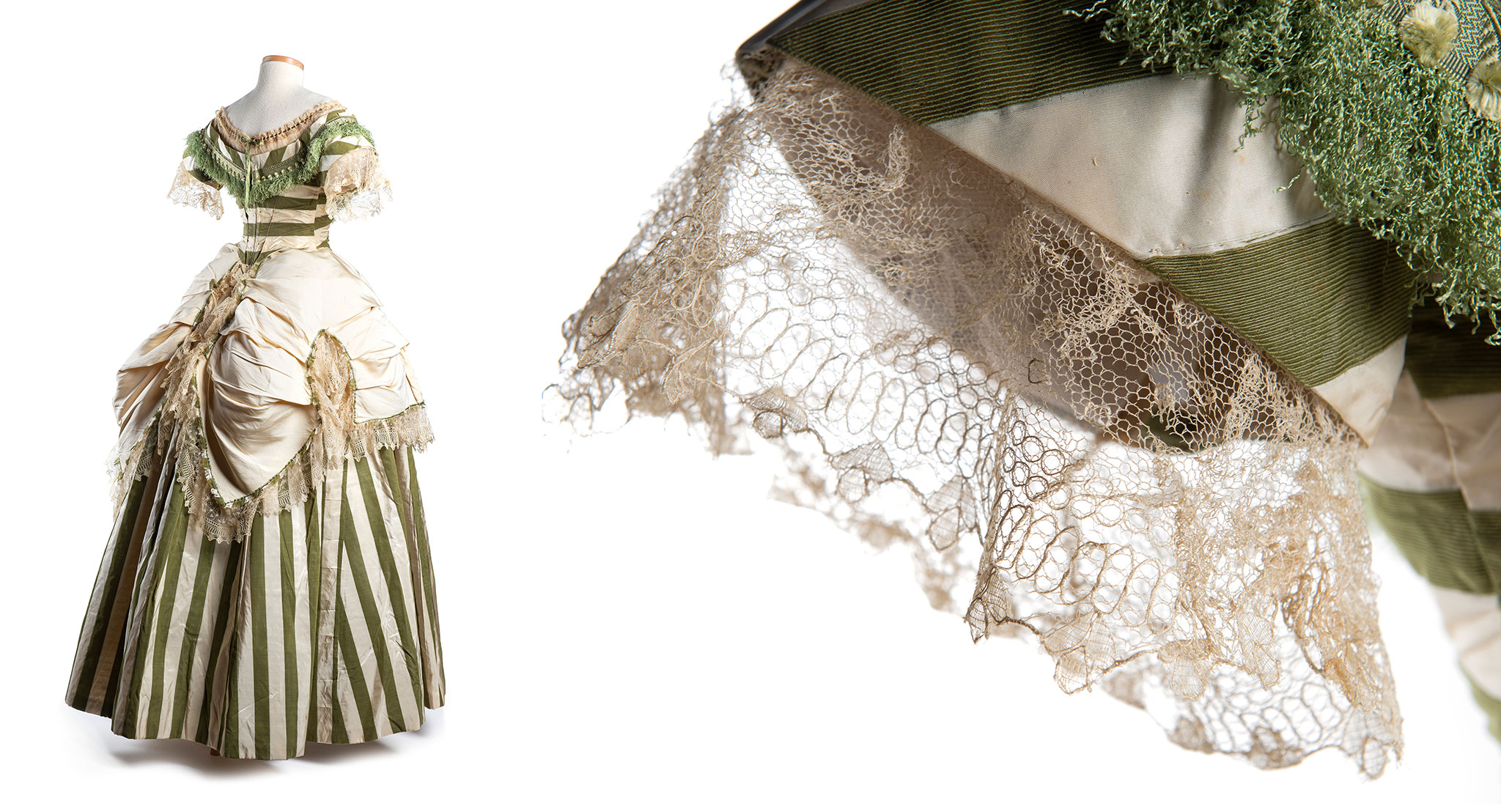Up Close and Personal: Researching Historic Garments
Gown of ivory taffeta silk, green corduroy velvet silk stripe, green silk fringe, and lace trim
The Historic Textiles Gallery has a new exhibit on view now: The Lawn Party: From Satin to Seersucker. In an “unprecedented” era when large gatherings have been discouraged and fashion has trended towards leisurewear, this exhibition is a celebration of getting dressed up for an outdoor party. Bringing a hint of glamour to a trying time, the garments on display were selected with a mind towards the grand idea of “after.” What will you be wearing this summer, as the pandemic hopefully abates and we can spend more time with friends and family?
One of my favorite parts of exhibit work is examining each garment carefully before it goes on display. This serves two purposes:
1- To assess the condition of the object, and make any needed repairs or stabilizations before it goes on a mannequin
2- To see if I can learn anything new about it from a repeat examination, adding to the knowledge of previous curators.
This green and ivory striped silk dress was one of my priorities for this exhibit, as it was one of the older pieces in the show and more tricky to dress than most of the 20th century garments.
In examining it for condition, I noted the various stains and places where it had small holes or discolorations. However, the biggest challenge was the lace, which was very delicate and torn along the cream silk polonaise overskirt. Some very basic stitching stabilized the lace enough to be put on exhibit, and the database record was updated to note that a professional conservator should formally repair the lace in the future.
Progress pictures of the polonaise overskirt repairs
Examining garments up close to prepare them for dressing also allows for a better understanding of their construction and silhouette on the body. When this garment arrived at the museum, it was dated to the 1840s, but later experts thought it might be closer to the 1860s-70s, based on the polonaise overskirt and the strong striped pattern. However, it was only in putting the garment on a mannequin designed for a corseted silhouette that the dress came to life.
If the dress had been from the 1860s or even early 1870s, it would have likely had a slight train, with the fullness focused towards the back of the skirt. Instead, the skirt draped equally around the waist, creating the more bell like shape of the 1850s. With some additional adjustments in dressing, it was clear that the neckline was meant to sit off the shoulders, rather than rounded as previous researchers had indicated. This change, combined with the fringe at the bustline, pointed bodice, and short sleeves trimmed in lace meant that the gown was most likely from c. 1855. A direct comparison can be made to gowns seen in a painting by German artist Franz Xaver Winterhalter of “Empress Eugénie Surrounded by her Ladies in Waiting” which was painted that very year.
“Empress Eugénie Surrounded by her Ladies in Waiting” by Franz Xaver Winterhalter, 1855 as seen in the book Fashion: The Definitive History of Costume and Style, published by the Smithsonian in 2012.
This date is still consistent with the age and potential use of the likely wearer, Henrietta Aiken Rhett (1836-1918), whose descendants donated the gown to the Museum. Therefore, the date for the gown was changed in the database, and adjustments were made to the style of the underpinnings supporting the dressed garment.
Additional views of the gown and details of the lace
I hope you will come visit the Museum and see the dress in person, now on display in The Lawn Party: From Satin to Seersucker, open through September 19, 2021!





